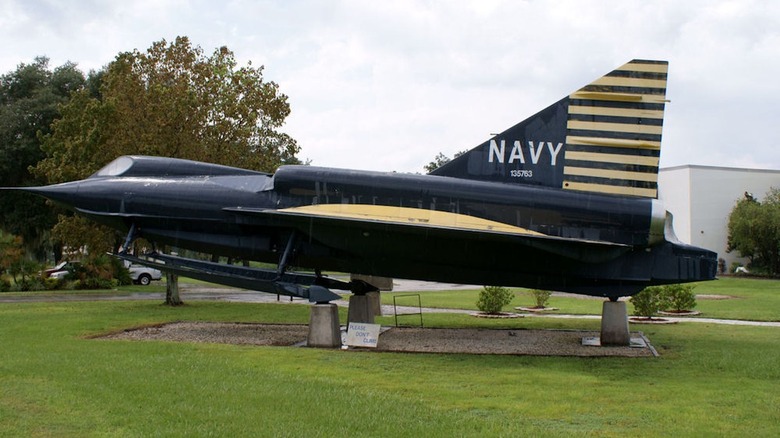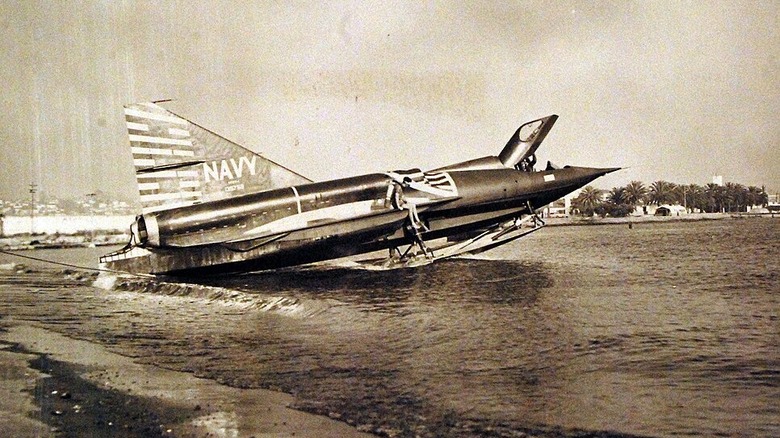Convair Sea Dart: The Seaplane Jet Fighter That Rode On A Pair Of Hydro-Skis
There are plane prototypes, and then there's the Convair Sea Dart, which at its heart, was basically just a jet fighter sitting on top of a pair of water skis.
Since oceans cover over 70% of the Earth's surface, the Navy of the 1950s devised a stratagem referred to as a "Mobile Base Concept." It was an idea wherein it could house and deploy water-based fighter planes anywhere in the world, thereby giving them a fast-response tactical advantage should a conflict arise.
In 1948 the Navy sent out a request for proposal (RFP) to build a single-seat supersonic fighter that could take off out of the water like conventional prop-based seaplanes had been doing for years. In 1951 it awarded the contract to San Diego-based Convair, whose design team had also built the Air Force's delta-winged XF-92A and F-102 Delta Dagger interceptor. The Navy initially wanted two test planes rigged with a pair of retractable hydro-skis, which had the same lifting properties as water skis used by people.
Two years later, in April 1953, the XF2Y-1 aircraft (aka the "Sea Dart") made its first test flight within the confines of San Diego Bay. It became the first delta-winged-shaped seaplane and the first combat plane of any kind to be fitted with the aforementioned retractable hydro skis. In August 1954, with test pilot Charles E. "Chuck" Richbourg behind the stick, it hit supersonic speed during a shallow dive. It was the only time it ever did so.
[Image by Valder137 via Wikimedia Commons | Cropped and scaled | CC BY 2.0]
Water rudders, spray rails, breaker strips and skegs ... oh my!
Between 1952 and 1957, five Sea Darts were built and tested, but only three ever actually got off the ground (or the water, in this case). Convair completed the last two planes but never installed the engines.
The first XF2Y-1 prototype was powered by twin after-burning Westinghouse J34-WE-32 engines (3,400 pounds of thrust). However, it was so underpowered that a change was made to the more powerful J46-WE-12B with 4,600 pounds of thrust. The engines were attached to the top of the plane to keep seawater away, but a freshwater injection system was still needed to remove deposits left by the salt water.
Some of the more unique features of the Sea Dart were things called the water rudder, forebody spray rail, breaker strip, and skeg. It used a set of dive brakes (aka water brakes) attached to the lower rear of the fuselage, and while taxiing around like a duck, used water rudders to maneuver. The bottom of the hull was constructed with several watertight compartments to keep it from sinking should it get punctured.
The aircraft could roll down a ramp into the water using small wheels on the rear of the skis with another located on the tail. Once in the water, the wheels on the skis turned 90 degrees and tapered back into an aerodynamic position wherein the plane could take off.
This dart tragically missed the mark
The Sea Dart had a wingspan of 33 feet 8 inches, a length of 51 feet 1.5 inches, and a gross weight of 22,000 pounds. Early testing quickly proved that vibration and pounding were far too rough on pilots, especially in choppy water, so the Navy changed the twin hydro-ski idea to a much wider single ski, which helped but did not altogether fix the problem.
Since it was always meant to be a combat fighter, it needed armaments. According to the Military Factory, it would have included 4x20mm Colt Mk12 cannons, air-to-air missiles, and folding-fin aerial rockets.
In November 1954, a few months after hitting supersonic speed in August, Charles E. "Chuck" Richbourg jumped into a second newly constructed Sea Dart (designated YF2Y-1). During a low-altitude high-speed pass — in front of the press and shown on live television — the plane suddenly disintegrated, and Richbourg died.
In the end, the Sea Dart proved the feasibility of a water-based supersonic fighter seaplane. Unfortunately, between a lack of funds and operational requirement approval, bad press from the tragic accident, and a change in tactical doctrine with advances in aircraft carrier launch and recovery systems, the Sea Dart project was scrapped in 1957. But not before racking up over 300 test flights.
The Pentagon changed how it named aircraft in October 1962, and the F2Y was renamed the F-7A. The four remaining planes were initially put into storage but eventually were loaned out to air museums around the country. One is currently on display at the San Diego Air & Space Museum in Balboa Park.

